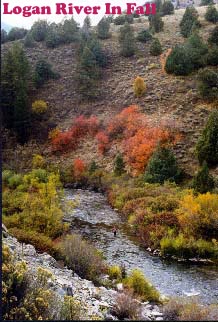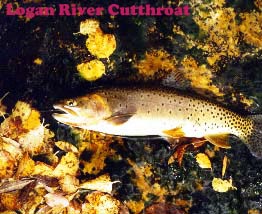|
|
Success on Logan River
By Dave Webb 
I had the pleasure of fishing the Logan River on Oct. 2. It was one of those rare days when the moon and stars align and everything goes perfectly. Ethereal is the word that comes to mind. The kind of experience that inoculates against the stresses of modern life.
A warm breeze was pushing storm clouds across the sky as I drove up the canyon. There was the hint of rain in the air and the promise of a major, winter-like storm scheduled to arrive that evening. The storm would leave snow on the ground in the high country by morning.
Golden aspen and willow leaves bowed and curtseyed and sometimes fluttered down onto the water's surface as I started fishing my way upstream. The fall colors were at their peak and the drive up the canyon had been spectacular.
My plan was to survey the water by fishing in several spots, so I could write a summary about the river. But I hadn't planned on a caddis hatch way in the Franklin Basin that afternoon. The hatch was not heavy - just a bug here and a bug there. Just enough to keep the fish interested and focused on the surface.
 Now and then I would see a fish
rise, and I would quickly position myself and cast to that fish. But I didn't see rising
fish in most areas, and that didn't matter a bit. I cast to likely spots and enjoyed
take after take. The fish weren't picky. Anything vaguely resembling a caddis would draw
their interest.
Now and then I would see a fish
rise, and I would quickly position myself and cast to that fish. But I didn't see rising
fish in most areas, and that didn't matter a bit. I cast to likely spots and enjoyed
take after take. The fish weren't picky. Anything vaguely resembling a caddis would draw
their interest.
The Logan is a small, crystal-clear stream up in that area. The water is often overhung by willows and brush. Long casts are not possible in most spots because there is no room for a backcast. The stream offers a good variety of conditions including pools, riffles and undercut banks. It's one of those streams where you can't make a bad cast - it seems like fish are everywhere.
The water is an icy silver color and in most places you can see every rock on the bottom. I love watching my fly float proudly on the surface. Watching a trout glide up to the fly in a smooth, seemingly effortless motion. Suddenly the fly is gone. I raise my rod and the serenity of the scene vanishes as a fish thrashes the water.
I could have caught 50 trout that afternoon. The fish I caught were all cutthroats between 8 and 12 inches long. Not big, but sure fun to catch. They appeared to be fat and healthy.
It was hard for me to break away from the fast action in the Franklin Basin, but I wanted to try a couple other spots in the lower canyon - down where bright red oak leaves mixed with the brush along the stream to create a truly remarkable view.
I was surprised at the number of hoppers along the river's bank in the mid-canyon area. I was not prepared with hopper patterns - I figured they would be gone from the high country by that time. I talked to people who were fishing hoppers and they reported very good action.
There are cutts to 18 inches through much of the canyon, and large browns on the lower end. My experience suggests bigger fish are more common in the lower third of the canyon, but overall action is not as fast there.
The impoundments in the extreme lower canyon - called 1st, 2nd and 3rd dams - are stocked with rainbows throughout the summer and fishing there can be fast. Some browns are stocked in the lower section of the river, including the portion through town.
Fall is an excellent time to fish the Logan. Dry flies can be effective into the late fall - later than most people expect. Caddis make up the bulk of the fish's diet and imitations produce strikes long after the naturals are no longer available. The fish are so accustomed to seeing caddis that they will take imitations almost year-round. Blue-wings and midge patterns also work well, even when the weather turns cold. Standard nymphs are also effective, pheasant tail and chamois caddis are particularly good. Cased caddis can also be effective.
Fall is on of the best times to go after big browns in the Logan, and in other rivers. The browns spawn in the late fall and early winter. They become aggressive and readily attack minnow-imitating flies and lures. Muddlers, zonkers, woolly buggers and other large patterns are very effective.
Panther Martins and other spinners also work well. Cast them upstream and reel them quickly through holes.
The Logan is basically a wild-trout fishery. Essentially all of the fish found above the impoundments are the result of natural reproduction. Both browns and cutts reproduce well in the stream and stocking is not necessary.
Special regulations were imposed on the Logan River a few years ago. They are designed to protect the wild cutthroats, to ensure good numbers of fish, and to protect fish until they grow to a decent size. The regulations are summarized below:
Card Canyon Bridge upstream to the highway bridge at Red Banks Campground, including tributaries:
- Bait fishing is not allowed (artificial flies & lures only).
- The limit for any combination of trout and whitefish is 3 (2 fish under 12 inches and 1 over 18 inches. Only 1 trout may be a cutthroat, rainbow or their hybrid cross. All other fish must be immediately released.
- For unlicensed anglers 13 years of age or younger, the limit for any combination of trout and whitefish is 2 (2 under 12 inches, or 1 under 12 inches and 1 over 18 inches), and only 1 trout may be a cutthroat, rainbow, or their hybrid cross. All other fish must be immediately released.
From the highway bridge at Red Banks Campground upstream to the Idaho state line, including tributaries:
- Closed January 1 through 6 a.m. on the second Saturday of July.
- The limit for any combination of trout and whitefish is 3 (2 under 12 inches and 1 over 18 inches), and only 1 trout may be a cutthroat, rainbow or their hybrid cross.
- For unlicensed anglers 13 years of age or younger, the limit for any combination of trout and whitefish is 2 (2 under 12 inches, or 1 under 12 inches and 1 over 18 inches), and only 1 trout may be a cutthroat, rainbow or their hybrid cross.
The regulations have been effective in producing good fishing but the stated objective of increasing the number of larger fish has yet to be achieved.
DWR biologist Kent Sorensen said surveys have not yet been conducted to scientifically determine if the regulations are producing more big fish, but the reports he gets suggest there are few fish over 18 inches in the protected area. Still, there are a lot of fish to be caught and angler satisfaction appears to be high - higher than it was before the regulations.
Cutthroat trout are native to the Logan - they were found in the river when the first mountain men and Mormon Pioneers came into the area. Some cutts were stocked in the river years ago to supplement the natural population. Now biologists and conservationists wonder if the cutthroats in the river represent the native strain, or if the early stocking program hybridized the fish. The Bonneville cutthroat is native to the water, but the stoked fish were probably Yellowstone cutts. The two fish are genetically close and so far biologists have not been able to genetically identify the fish which now inhabit the river, Sorensen said.
There is a movement underway to restore both Yellowstone and Bonneville cutthroat trout to their native waters, and that movement could effect the Logan River. Both fish are candidates for protection under the Endangered Species Act. If protection is granted the federal government could take control of management and could potentially end sport fishing in the river.
That's one reason special regulations are needed on the river. It's important that the DWR be able to show that the wild cutthroat population is being protected and encouraged to expand throughout the Logan and its tributaries.